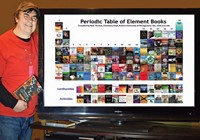Advertisement
Grab your lab coat. Let's get started
Welcome!
Welcome!
Create an account below to get 6 C&EN articles per month, receive newsletters and more - all free.
It seems this is your first time logging in online. Please enter the following information to continue.
As an ACS member you automatically get access to this site. All we need is few more details to create your reading experience.
Not you? Sign in with a different account.
Not you? Sign in with a different account.
ERROR 1
ERROR 1
ERROR 2
ERROR 2
ERROR 2
ERROR 2
ERROR 2
Password and Confirm password must match.
If you have an ACS member number, please enter it here so we can link this account to your membership. (optional)
ERROR 2
ACS values your privacy. By submitting your information, you are gaining access to C&EN and subscribing to our weekly newsletter. We use the information you provide to make your reading experience better, and we will never sell your data to third party members.
Energy Storage
Newscripts
Adventures with the periodic table
by Linda Wang
June 24, 2018
| A version of this story appeared in
Volume 96, Issue 26

Hollywood has a history of making up science to support its plotlines. In the blockbuster movie “Black Panther,” the titular Marvel Comics superhero wears a bodysuit powered by the fictitious metal vibranium. The element supposedly dissolves other metals, absorbs all sound, and is a strong mutagen. In the movie, production and use of this metal drives the economy of the fictional African nation Wakanda.
Vibranium also recently inspired two chemists to ask their students to think critically. In a letter in the Journal of Chemical Education, Sibrina N. Collins, executive director of the Marburger STEM Center at Lawrence Technological University (LTU), and LTU senior chemistry lecturer LaVetta Appleby describe how they used the popular film to probe students’ knowledge of the arrangement of the periodic table (2018, DOI: 10.1021/acs.jchemed.8b00206).
For extra credit on an exam, Collins and Appleby asked the students to write an essay answering these questions: If vibranium existed, where would it be found on the periodic table and why? What electron configuration would it have? And what would its elemental symbol be?
Most of the students said the metal should have the elemental symbol Vb, and several students suggested placing the metal among the f-block elements, the lanthanides and actinides. One student noted that in the movie, vibranium glows a bluish purple, suggesting that it might be radioactive, like uranium. Another student proposed that vibranium be placed under the main body of metals near the currently unnamed elements.
So what’s the right answer? There isn’t one, Collins tells Newscripts. “It’s about creativity and having fun.”
3-D-printable periodic table
In other periodic table news, Ezequiel Skorepa, a graduate student at the National University of Jujuy in Argentina, has designed a cylindrical periodic table that can be printed using a 3-D printer. The elements are in a hexagonal pattern, and the entire periodic table resembles a carbon nanotube.

Making each element of the periodic table took a lot of time, Skorepa tells Newscripts. It involved “doing many tests to find the ideal size so that the data of each element is printed well.”
Skorepa says he hopes people will use his periodic table design to generate greater enthusiasm and interest in chemistry. “It is very important to use new technologies to create more didactic forms of education,” he says. “Teaching is a fun way to awaken curiosity.” The printable files are available for free to the public at www.thingiverse.com/thing:2741581.
Linda Wang wrote this week’s column.Please send comments and suggestions to newscripts@acs.org.





Join the conversation
Contact the reporter
Submit a Letter to the Editor for publication
Engage with us on Twitter